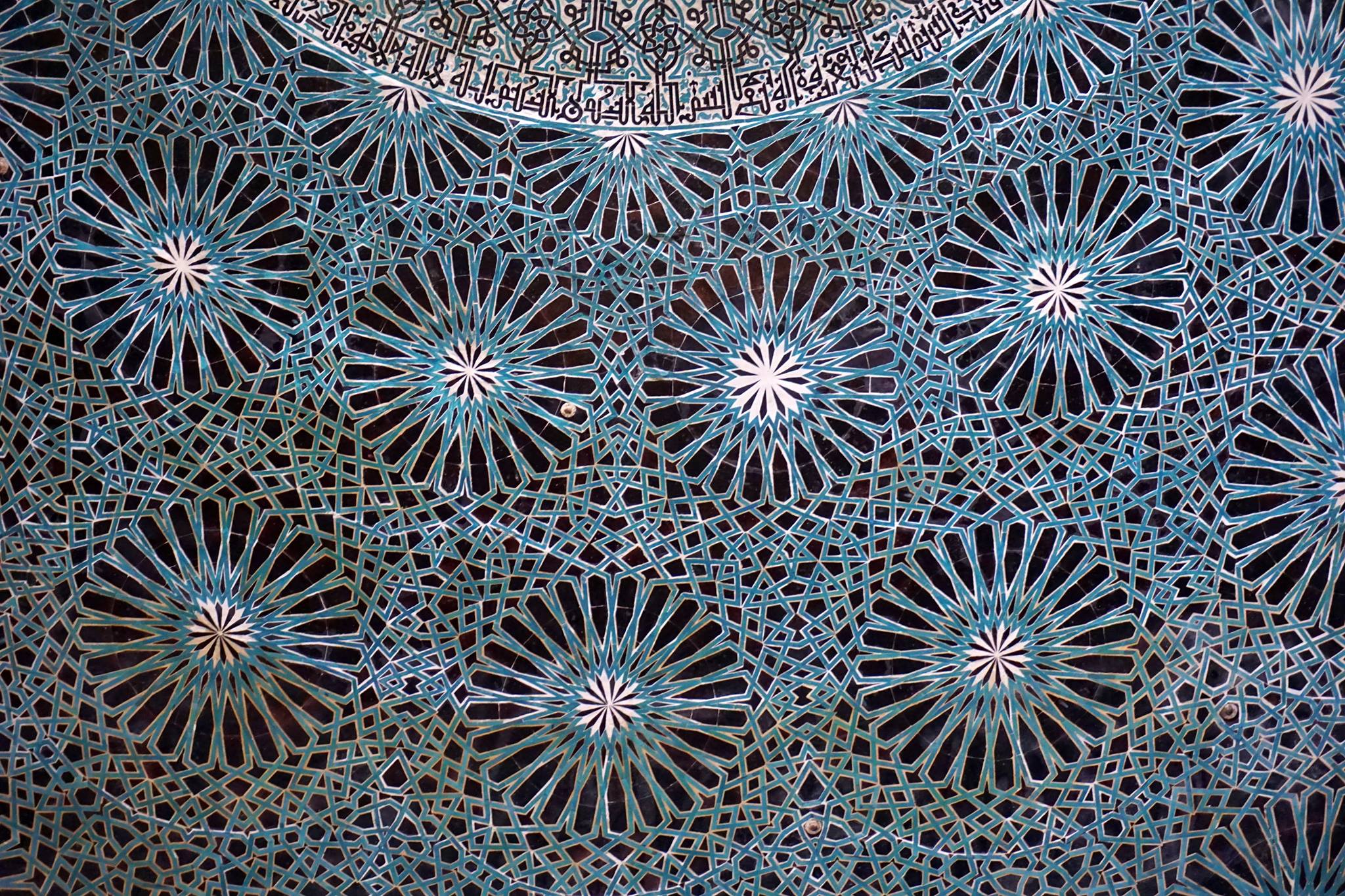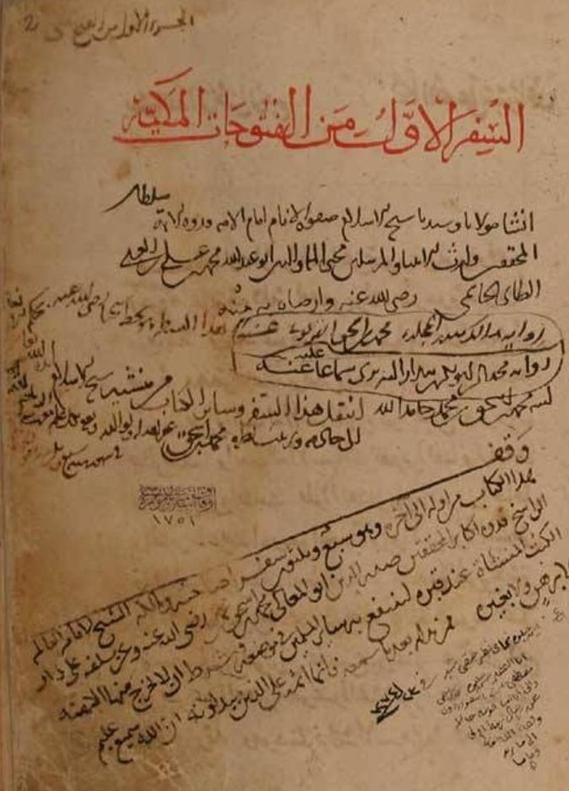Dunja Rašić on the Science of the Letters and the Art of Ibn ʿArabī
Written on August 17th, 2021 by Dunja Rašić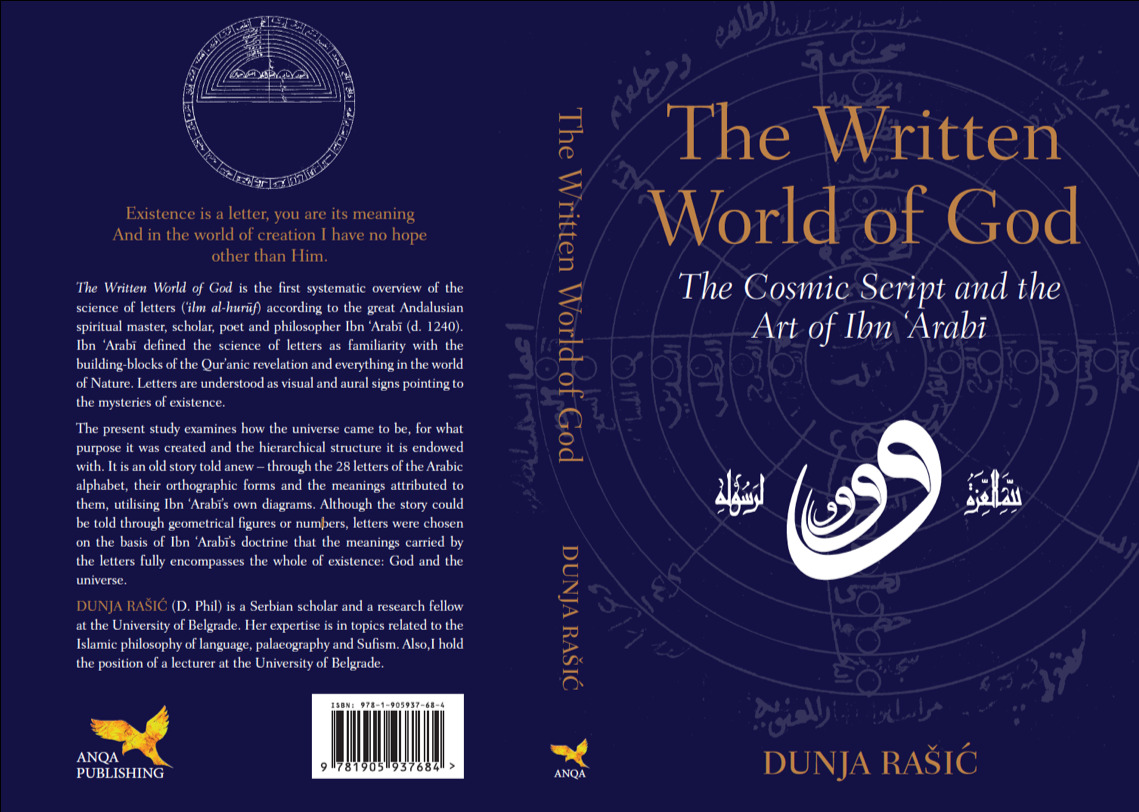
This post contains the introduction chapter of the author’s forthcoming book The Written World of God: The Cosmic Script and the Art of Ibn ʿArabī (Anqa Publishing, 2021). This book represents the first systematic overview of the science of letters (ʿilm al-ḥurūf) according to the great Andalusian spiritual master, scholar, poet and philosopher Ibn ‘Arabi (d. 1240). The Written World of God examines how the universe came to be, for what purpose it was created and the hierarchical structure it is endowed with. It is an old story told anew – through the 28 letters of the Arabic alphabet, their orthographic forms and the meanings attributed to them, utilising Ibn ‘Arabi’s own diagrams. Although the story could be told through geometrical figures or numbers, letters were chosen on the basis of Ibn ‘Arabi’s doctrine that the meanings carried by the letters fully encompasses the whole of existence: God and the universe.
Apart from God, Ibn ʿArabī believed, a man can speak, an angel can speak and a jinn can speak. However, human beings are the only ones with the potential to come to terms with the secret properties of letters. The science of letters (ʿilm al-ḥurūf) represents one of the central elements of Ibn ʿArabī’s teachings. Until today, it also tends to be perceived as one of his most abstruse. Ibn ʿArabī identified the science of letters as familiarity with letters, the Qurʾanic revelation and everything in the world of nature. To study the letters was to follow the visual signs pointing to the mysteries of existence.1 In many ways, this book is a commentary on, and an exposition of this statement. Ibn ʿArabī’s impact on Islamic intellectual history was extensive, a fact that is reflected in the continuing scholarly interest in his works. Nevertheless, a comprehensive study on his contributions to the Islamic science of letters has never been systematically undertaken. The absence of such discussions is regrettable as Ibn ʿArabī’s meditations on language and letters, even when analysed on their own, apart from other elements of his teachings, offer a comprehensive insight into his notions of the world and its Creator.
In the Akbarian tradition, the world was perceived as everything other than God (kull mā siwā Allāh).2 In accordance with the Islamic normative tradition, Ibn ʿArabī held that the world is a product of God’s speech. In his works, the world is commonly compared to a book inscribed on parchment unrolled (al-raqq al-manshūr). While the face of this parchment was thought to contain the Most Beautiful Names of God, its lower side stands for the world of nature.3 From this perspective, the act of genesis unfolds as ontological speech and writing. As early as the ninth century CE, grammarians of the Baghdad school believed they had found correspondences between the rules and regulations of Arabic grammar and the laws that govern the structure and nature of the universe. In the eyes of the early Arab grammarians, Arabic was a pure, flawless language, whose origins were traditionally perceived as divine. In Islamic culture, theories of the divine origins of the language were primarily based on 1) the Qurʾanic revelation and 2) the presumed qualities of Classical Arabic. The overview of arguments these theories have been based upon was compiled by al-Suyūṭī (d.1505) in the fifteenth century CE:
(Abū al-ʿAswad) al-Duʾalī stated that if the language was not the achievement of God, it would either have to be a product of agreement between the people or an invention of a single man. However, no one in his generation or in generations before his time has ever heard of an agreement and/or invention such as this – not even men as competent as the companions of the Prophet. Hence, language must have appeared with the appearance of the first human being in the world and it must have been created by God. (…) Abū ʿAlī al-Fārisī, God have mercy on him, said to me one day: ‘it (i.e the Arabic language) comes from God’ and he based his argument on the words of the Exalted One: ‘He taught Adam the names, all of them.’ This leaves no space for contradiction as it is possible that the interpretation of these words is ‘He (i.e. God) enabled Adam to start it (the language)’. Therefore, the idea that the language comes from God, praise be to Him, leaves no place for doubts. Even if a contradiction was to occur, it would inevitably crumble with the help of this argument.4
In Islamic intellectual history, grammarians, philosophers and religious scholars have been actively trying to come to terms with the properties of the Arabic language and its relation to thought and reality. Ignorant people have no clue on the importance of grammatical analyses, noted Ibn ʿArabī on the matter.5 Seven centuries later, a similar stand was advocated by Louis Massignon. ‘It is useless to examine the works of Muslim mystics,’ Massignon wrote, ‘unless one has studied very closely the mechanism of Arabic grammar, lexicography, morphology, syntax’.6 In reverence for the spoken and written language, Sufis have been long known for their habit of salvaging every scrap piece of paper with the Arabic letters on it, in fear of its power being desecrated otherwise. According to Annemarie Schimmel, this custom survived in Bengali rural areas even today.7
Originally proposed by grammarians of the Baghdad school,8 popular analogies between the rules and regulations of the Arabic grammar and the structure and nature of the universe subsequently led Sufis to identify nature studies as the reading of a macrocosmic book. Apart from the universe, the great book of the macrocosm, Sufi works on the science of letters equally focused on the physiognomy and nature of human beings (i.e. on the microcosm) and the text of the Qurʾanic revelation. These were the main research objects of the Islamic science of letters, which are traditionally referred to as the three great books. Sufis like al-Tirmidhī (d.892) maintained the belief that familiarity with the content of the three great books could be achieved through familiarity with the letters of the Arabic alphabet. ‘Contained in the letters,’ noted al-Tirmidhī, ‘is the complete knowledge of the primal beginnings, God’s attributes and names. They also contain knowledge of His regulating the world which covers from the creation of Adam to the day of the appointed time.’9 Nothing exists before being named. When God created Adam in His own form and taught him the names of all things in existence, He also endowed him with the potential to master the science of letters. Following the temptations of Satan, the descendants of Adam lost their inherent familiarity with letters. As a result, proficiency in reading the ontological language of the three great books required special training and divine mercy to support it. Masters of this art were thought to be able to use letters to cure illnesses, converse with animals, conquer death and return to the pure, primordial state of being. This was the final stage of enlightenment and the ultimate goal of the science of letters.10
While the present study seeks to provide an insight into the long-standing, traditional appreciation of letters in medieval Islam, a comprehensive study on the science of letters would require familiarity with all things in existence. The present study is not as ambitious, and its research scope is mostly limited to the surviving works of Ibn ʿArabī and several eminent Akbarians: Ṣadr al-Dīn al-Qūnawī (d.1274), Muʾayyid al-Dīn al-Jandī (d.1300), Dawūd al-Qayṣarī (d.1350), Maḥmūd al-Qāshānī (d.1335) and ʿAbdi b. Muḥammad al-Būsnawī (Bosnevi, d.1644). In broad terms, the present study examines Ibn ʿArabī’s science of letters as a distinct hermeneutical approach to the sacredness of the Arabic language. It considers how the universe came to be, for which purpose it was created and the hierarchical structure it was endowed with. It is an old story told anew: through the letters of the Arabic alphabet and the meanings attributed to them. Alternatively, the story could have been told by focusing on numbers instead. However, letters were chosen on the basis of Ibn ʿArabī’s belief that ‘the meaning of letters fully encompasses the absolute existence: God and the world, or more specifically, He who imposes the law and those upon whom the law is imposed’.11
In specific terms, the present study is concerned with the major research objectives, field of inquiry and the changing fortunes of the science of letters in Islamic intellectual history prior to the late fourteenth century CE. At this point, Ibn ʿArabī was yet to be generally known as the Greatest Shaykh – and the science of letters was yet to be established as the most eminent of sciences under the patronage of the Timurid, Safavid, Mughal and Ottoman rulers.12 In an attempt to come to terms with Ibn ʿArabī’s contributions to the Islamic science of letters, the present study pivots on two sets of research objects: textual evidence and the visual arts. In addition to Ibn ʿArabī’s magnum opus The Meccan Revelations (al-Futūḥāt al-Makkiyya) and Bezels of Wisdom (Fuṣūṣ al-ḥikam), the present study examines the textual evidence from several other short treatises dealing with the topic – with a special emphasis on The Book of Alif (Kitāb al-Alif), The Book of the Letter Bāʾ (Kitāb al-Bāʾ), The Book of Mīm, Wāw and Nūn (Kitāb al-Mīm wa-l-Wāw wa-l-Nūn) and The Book of Majesty (Kitāb al-Jalāla). Apart from the mutual topic, the aforementioned works share a general assumption that the properties of each letter are determined by its 1) shape, 2) place of articulation and 3) the spirit that governs it. In most cases, Ibn ʿArabī uses the word spirit (rūḥ) as a synonym for the meaning of letters. However, this term can also stand for the power they contain.
In his works, Ibn ʿArabī differentiates between three types of letters: written, spoken and summoned.13 When a letter is written, its spirit remains passive and silent. Of its own accord, it will take no action whatsoever against the writer and reader of the text that contains it. The existence of these spirits is tightly connected to the fate of a written text. However, once a letter has been spoken, its spirit rises into the air, and people connect with it by means of hearing. While the spirits of a written letter can be easily altered and eliminated with the destruction of a written text, spirits of the spoken letters are more resilient in nature.14 These spirits merge with one another as sentences are being formed and tend to stay in the air long after the speech has ended. Eventually, the spirits of spoken letters ascend and return to the Creator. However, if spoken words were poisonous or bitter, their spirits might return to haunt the speaker. Ibn ʿArabī believed that an audience is usually safe from the negative effects of the spoken letters. In this aspect, his teachings evoke the general stand of the Arabic grammar tradition that it is up to listeners to decide on the meaning of a sentence. Unless he invests his personal energy to fuel the negative vibrations of a spoken letter, a listener will remain unaffected by it. In contrast, the summoned letters (al-ḥurūf al-mustaḥḍara) have a permanent effect and hold the power to influence a listener irrespective of his will and actions. Spirits of the summoned letters get to be manifested when the act of writing is followed by the act of speaking and imbued with the spiritual concentration (ḥimma) of a summoner. In this case, speaking and writing serve to help one’s imagination to form a clear image of the letter he intends to summon. Provided that the spiritual concentration is strong enough, the summoned letters will pass from the imagination of a summoner to the imaginal world (barzakh) to do the bidding of their master. In rare cases, however, the act of reading from the Qurʾan was also thought to be sufficient to invoke the spirits of the letters. In their shape and effect, the summoned letters were thought to be stable. Alternations in pronunciation and handwriting have no effect on the summoned letters, and their properties are solely determined by the spirits that govern them.15 According to Ibn ʿArabī, few people were proficient in summoning a single spirit of a single letter – and fewer still were capable of summoning multiple letters at once. The summoning process was thought to be a dangerous, ‘repugnant knowledge, both intellectually and according to the (Islamic religious) law’.16 For in spite of the fact that the summoned letters have been attributed with a variety of pragmatic features, Ibn ʿArabī primarily associated them with the dark arts. While his works contain an abundance of information on the meaning of letters, relatively little has been said on the summoning process and the perceived functions of the spirits of letters. As a result, the present study mostly deals with the spoken and written letters of the Arabic alphabet. While Ibn ʿArabī’s analyses of phonology and the spirits (i.e. meanings) he attributed to each letter of the Arabic alphabet are easily accessible from the contemporary editions of his works, his inquiries into the orthographical structures of letters are closely related to the properties of his handwriting and calligraphy.
In his Art of Islam, Titus Burckhardt maintained that ‘it can be said without fear of exaggeration that nothing has typified the aesthetic sense of the Muslim peoples as much as the Arabic script’.17 While the term ‘calligraphy’ comes from the Greek words for beauty (kallos) and writing (graphein), Ibn ʿArabī’s meditations on the topic extend well beyond the properties of elegant handwriting. In Sufi circles, calligraphy was perceived as a technical science which involved the production of letters in accordance with the strictly defined geometrical ratios, strokes and angles – each of which is imbued with symbolic meanings. Firm in the belief that proficiency in calligraphy can lead to familiarity with the meaning of letters, Ibn ʿArabī analysed the orthographic forms of letters with geometric precision. By means of calligraphy, his notions of the ideal shapes and the meanings of letters are directly put into practice. In order to come to terms with Ibn ʿArabī’s meditations on the orthographic structures and the symbolic values he attributed to them, special attention will be given to the twenty-seven holographs and the several dozens of surviving autographs in Ibn ʿArabī’s own hand. The properties of Ibn ʿArabī’s calligraphy will be analysed in accordance with the criteria provided by the major Sufi thinkers and the aesthetical concepts originating from the Andalusian tradition. However, the present study also deals with the cryptographic scripts Ibn ʿArabī developed, together with their putative keys and relationship to the ‘standard’ letters of the Arabic alphabet.
The defining parameters of the present study – the science of letters, pre-modern cosmology and the interpretations of the rules and regulations of Arabic grammar in Sufi literature – present us with many challenges, both conceptually and methodologically. Most of these challenges spring from the fact that Ibn ʿArabī perceived the science of letters as a mystery forbidden to be disclosed in books. ‘It is a noble science in itself,’ Ibn ʿArabī recorded, ’though it is quite rare to practise it without being affected by it. It is thus preferable not to seek it since it is with this science that, in eternity, God privileged his saints.’18 As a result, the relevant passages from Ibn ʿArabī’s works are intentionally vague and seemingly full of contradictions. Faced with a similar obstacle as he was attempting to conduct a research on Ibn ʿArabī’s cosmology, William Chittick noted how easy it would be to have Ibn ʿArabī say whatever one wants him to say. In Ibn ʿArabī’s teachings, Chittick observed, everyone seems to be able to find what he wants alongside a proper quote to support his view.19 On his side, al-Nābulusī (d.1731) argued that this is how it is supposed to be. In his commentary on Ibn ʿArabī’s Bezels of Wisdom, al-Nābulusī noted that, when it comes to Ibn ʿArabī’s works, there is no such thing as a single ‘correct’ interpretation. In this aspect, Ibn ʿArabī’s works can be compared to the opposing views different Muslims have on God. ‘The God in whom one must have faith is One,’ al-Nābulusī explained. ‘However, His appearance differs in [the writings] of the people of the doctrine, people of discursive reasoning and people of the witnessing states (aḥwāl).’20 Differences in interpretations were believed to occur due to different capacities of the people conducting them. This can lead to dogmatic clashes between the people in spite of the fact that the God they worship is one and the same.21 Conducted in October 2012, Establishing Ibn ʿArabī’s Heritage Project research identified eighty-four written works which were, without any possible doubt, composed by Ibn ʿArabī.22 Over the course of centuries, these were the subject of countless different interpretations. The present study on the Islamic science of letters is yet another product of the continuing scholarly interest in Ibn ʿArabī’s works. As such, it does not presume to be a definitive study: what it offers is the first systematic overview of the topic. Paradoxes that could not be resolved through the course of the present study and the seemingly contradictory parts of Ibn ʿArabī’s teachings are enumerated next to one another. Some of them, like the practical usage of the talismans and Ibn ʿArabī’s notions of the hierarchy and articulation of the letters bāʾ and hāʾ are tasks for studies to come.
Apart from obfuscations, data exposition was another major problem of the present study. The Islamic science of letters traditionally associates the sequence of the letters of the Arabic alphabet with the order in which the universe came into existence. Data exposition of the present study was originally set to be modelled on this sequence – as presented in the surviving works of Ibn ʿArabī:
The number of letters, by the agency of the Breath, is twenty-eight: no more, no less. The first is the Intellect and this is the Pen, as stated by the Prophet: ‘The first thing that God created was the Intellect’ – or in another report: ‘The first thing that God created was the Pen’ reads a certain hadith. The first thing that God created from the Breath, the Mist, was receptive to the first created things in the universe in the following order: the Intellect, and this is the Pen [i.e. hamza], then the Soul and this is the Tablet [hāʾ], then the Universal Nature [ʿayn], then the Dust [ḥāʾ], then the Universal Body [ghayn], then the Form [khāʾ], then the Throne [qāf], then the Pedestal [kāf], then the Starless Sphere [jīm], then the Sphere of the Fixed Stars [shin], then the first heaven [yāʾ], then the second [ḍād], then the third [lām], fourth [nūn], fifth [rāʾ], sixth [ṭāʾ] and the seventh heaven [dāl] – and then the Orbit of Fire [tāʾ], Air [zāy], Water [sīn] and Earth [ṣād], then the minerals [ẓāʾ], then the plants [thāʾ], then the animals [dhāl], then the angels [fāʾ], then the jinn [bāʾ], then the human beings [mīm] and then the step-levels of spiritual elevation [wāw].23
The introductory chapter on research objectives and history of the science of letters was thus set to be followed by twenty-nine chapters: one chapter for each letter of the alphabet. These were to analyse the phases of the genesis as it evolved, starting with alif, the letter that is not a letter, and ending with the letter wāw. However, the surviving works of Ibn ʿArabī do not treat the letters equally. While some letters are barely mentioned, letters like alif, bāʾ and yāʾ were dedicated a whole book each. This is not necessarily an implication of the importance of each letter: Ibn ʿArabī never presumed to have divulged all the secrets of the science of letters. Such a task would have been beyond his powers. By his own admittance, he had no knowledge of the orbit period of the letter nūn. The secret nature of the letter jīm in relation to celestial orbits was another mystery he unsuccessfully tried to resolve.24 Ibn ʿArabī’s research interests and familiarity with the meaning of specific letters are reflected in the amount of writings he dedicated to each of them. ‘In each letter there is a fountain of insight different from any other, a fresh flavour different from any other and a pleasant taste different from any other,’ noted Abū Saʿīd al-Kharrāz (d.899) on the meaning of letters.25
Irrespective of its prominence in the surviving works of Ibn ʿArabī, within the scope of the present study, each letter of the Arabic alphabet will be allowed to tell its story – for as the early Sufi proverb goes, ‘there is no letter that does not worship God in the Arabic language in its own way’.26 Similar notions appear to have been widespread among Sufis – but in spite of this fact, clear division of research units and a well-built narrative structure are atypical for Sufi works on the science of letters. In this aspect, the surviving works of Ibn ʿArabī are no exception. Overlapping content, the complexity of the research object and the systematic lack of data exposition in Ibn ʿArabī’s works set a major challenge for all future studies dealing with the topic. For example, the story of a relationship between the Creator and the created could be told through the analysis of Ibn ʿArabī’s writings on the letters bāʾ, mīm, lām-alif and/or the disjoined letters alif-lām-mīm. While the concept they refer to is the same, each of these letters offers a new angle to the story. In spite of this fact – or precisely because of it – data exposition of the present study required several compromises to be able to adhere to the contemporary standards of academic writing. In order to avoid redundancy, letters whose meanings are similar were occasionally analysed together, within a single chapter of the present study. Lām-alif, which Ibn ʿArabī treated as the twenty-eighth or twenty-ninth letter of the alphabet, was analysed as the second letter of the present study instead. In this case, a narrative based on the order of the alphabet was abandoned in favour of greater clarity of data exposition. In all other cases, data exposition follows Ibn ʿArabī’s sequence of letters. In addition, several chapters of the present study contain sub-chapters dealing with Ibn ʿArabī’s interpretations of the letters in different words and sentences. While letters of the Latin alphabet typically appear as individual glyphs in the text, the Arabic letters connect with one another to form an organic band (Fig. 1).
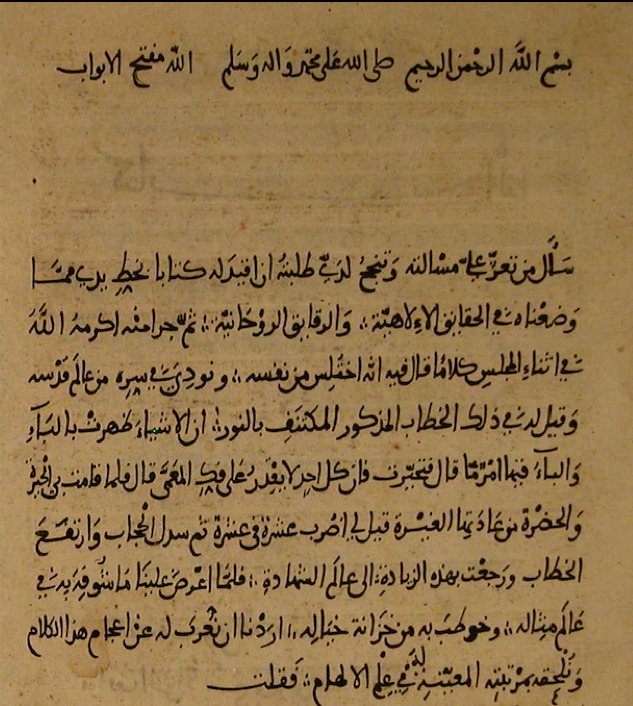
Since the rules of orthography demand that most Arabic letters are connected with a preceding and a following letter, the shape of each letter can be subjected to changes in different words and sentences. The orthographic forms of letters are chiefly determined by the position they occupy in a word. Apart from their isolated, independent form, the Arabic letters have three further forms: initial, medial and final (Table 1). These forms were thought to be crucial for determining the meaning of a letter. The Islamic science of letters traditionally held that isolated letters are superior to complex words and sentences.27 As a result, Ibn ʿArabī’s research was mostly limited to the isolated forms of letters – and unless specified otherwise, all analyses conducted within the scope of the present study pivot on the isolated forms as well. Not only did Ibn ʿArabī believe that the meaning of letters is determined by their position, he also held that the meaning of each letter can vary from one word to another. Properties of the letter qāf in the imperative mood of the verb ‘protect’ (qi!) were thus thought to be lost in imperative forms of other verbs. In this aspect, Ibn ʿArabī’s notion of letters can be compared to chemical elements and the great variety of substances they form. ‘Letters are like natural medicines – no, they are like all things which have a special usage when used on their own and a special usage when used in combinations,’ noted Ibn ʿArabī on the matter.28 When applicable, contrasting interpretations of individual letters in different words and sentences are enumerated next to one another in a chapter dealing with the letter in question.
Table 1 The Arabic script in the common hijāʾī order
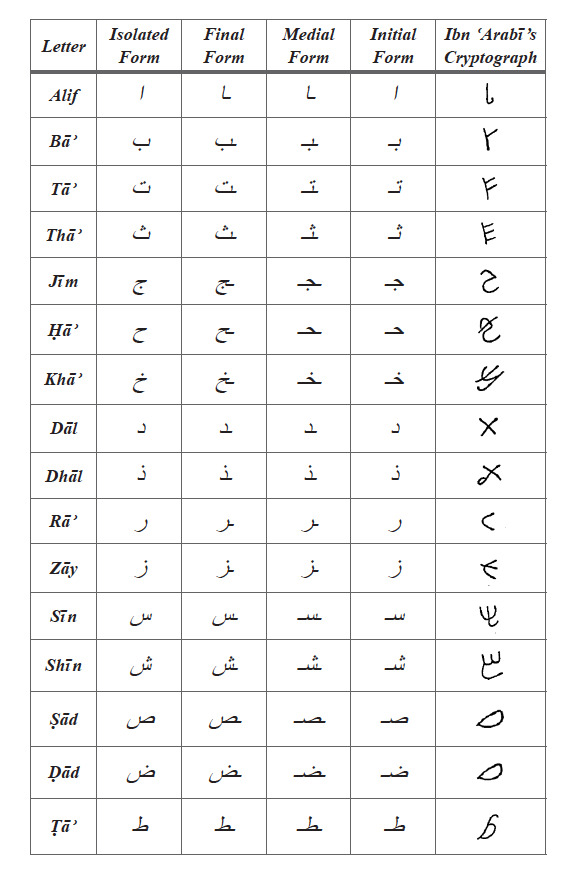
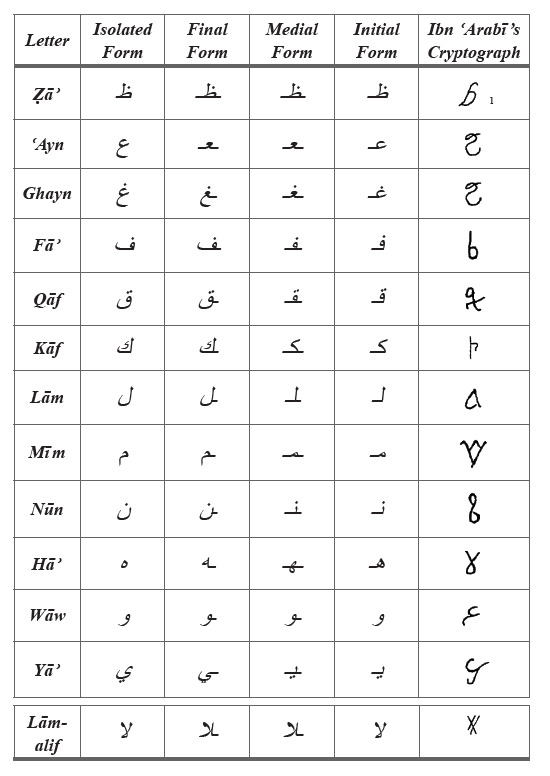
In order to minimize the possibility of misinterpretation, central to the approach of the present study was, whenever possible, to let Ibn ʿArabī speak for himself. Ibn ʿArabī recommended this approach in the second chapter of The Meccan Revelations:
No scholar can declare wrong an interpretation that is supported by words [i.e. a quote]. However, it is not necessary to uphold the interpretation or to put it into practice, except in the case of the interpreter himself and those who follow his authority.29
The second possible approach to Ibn ʿArabī’s writings on the science of letters was also proposed by the author himself: ‘Verify for yourself what we cited and have it clarified,’ Ibn ʿArabī suggested, ‘and there will appear to you strange wonders that will bewilder the intellect with the splendour of their beauty.’30 Alongside divine mysteries of eternity, imagination and timelessness, the science of letters reveals its secrets only by means of revelation. A revelation received by one prophet could be easily granted to another. While the notion of divine revelation (kashf) has been extensively researched in the fields of history of philosophy and religious studies, Ibn ʿArabī was sceptical regarding the possibility of conducting a successful research on divine mysteries by means of the rational mind. He primarily perceived kashf as knowledge granted by God to those who are pure of heart. Such knowledge is as hard to convey by means of everyday speech as ‘the taste of honey, bitterness of aloe, the pleasure of sexual intercourse, love, passion, desire and the like – for these are the things that cannot be comprehended by the one who is incapable of them nor by the one who did not experience them’.31 When it comes to the science of letters, it is therefore appropriate to say that he who has no kashf has no knowledge. Faced with a limited potential of the spoken and written language, Sufis turned to symbols and analogies to instruct those who were yet to experience the spark of revelation. In his attempts to express the ineffable, Ibn ʿArabī also found it convenient to rely on the visual arts. What could not be expressed in words thus found its expression in diagrams and calligraphy. In the twenty-seven surviving holographs of Ibn ʿArabī’s works, thirty diagrams have been preserved. These diagrams are the visual grammar of Ibn ʿArabī’s works. He believed them to be necessary so that a seeker, by the means of imagination, can gain nearness to knowledge which cannot be obtained by the rational faculty.
The disciple will represent in himself the spiritual meaning (maʿnā) in materialized form, thus facilitating its explicit expression by having it integrated in his imagination. The one who considers [the spiritual meaning in materialized form] will then aspire to complete his consideration and get to know the totality of its spiritual meanings. This is due to the fact that sensation (al-ḥiss), once it’s poured into the mold of form and figure (qālab al-ṣūra wa al-shakl), is taken with the spiritual reality. The disciple finds pleasure in it, it provides him with delight - and this leads him to realize what manifests to him the figure and what is materialized to him by this form.32
With the rising popularity of Ibn ʿArabī’s works, from the fourteenth century CE, Sufis began to demonstrate an increasing tendency to rely on the visual arts to make their works more accessible to the general public. As a result, the artistic value of Sufi manuscripts increased, with scholars becoming increasingly proficient in the (re)production of elaborate diagrams. Not only were diagrams a central feature of Ibn ʿArabī’s method of exposition of the science of letters and other mysteries divine – as such, they also served as a foundation for the data exposition of the present study. Following the introductory chapter on the field of inquiry and origins of the science of letters, Ibn ʿArabī’s diagrams are analysed alongside segments of the universe they were said to represent. For the sake of further clarity, several noteworthy illuminations from the later manuscripts are also included. Through his diagrams, Ibn ʿArabī was determined to help adepts with reduced capacities (al-afhām al-qāṣira) to come to terms with the higher spiritual realities. By relying on the visual arts, it was my intention to present Ibn ʿArabī’s teachings in an innovative and easily approachable way – just as Ibn ʿArabī himself intended to do in the thirteenth century CE.
In the first part of the present study, we will identify research objectives of the Islamic science of letters and determine which of them were thought to be susceptible to rational analyses. This was intended as a foundation for The Act of Genesis, the second part of the present study, which examines the properties and symbolism attached to each of the twenty-eight letters of the Arabic alphabet. In the eyes of Ibn ʿArabī, any attempt at conducting a research on the science of letters was a brazen, highly improper thing to do – for he believed that it is not up to scholars to interpret the revelations they did not receive for themselves.33 However, this is something we will have to live with. Being powerless to induce the arrival of a revelation, we shall approach the topic in the only way we can: meticulously and rationally. Research units that belong to the domain of revealed knowledge and were, as such, thought to be unsusceptible to the intellectual capacities of the mind, are to be systematically presented in the wider historical and cultural context of Islamic intellectual history. Without the protection God grants to His messengers, this approach represents a calculated risk. For, according to Ibn ʿArabī, the possible consequences for any misstep are madness, misery and slander in this life – with the fires of hell awaiting in the next. But even though the philosophers from Ibn ʿArabī’s Contemplations of the Holy Mysteries were said to be sentenced to hell for engaging in rational interpretations of divine mysteries, in Islam it is also said that ‘God loves the artisan who seeks perfection in his craft’.34
Author bio
Dunja Rašić (PhD Free University Berlin) is a lecturer at the University of Belgrade. Her academic interests include philosophy of language, Akbarian cosmology and the philosophical and theological thought of the early Islamic Middle Ages. She is currently working on several book projects, including The Devil Within: Jinn Doppelgangers, Mages and the Sages and a critical edition and translation of al-Bosnevī’s commentary on pseudo-Ibn ʿArabī’s al-Qaṣīda al- tāʾiyya.
Copyright Dunja Rašić, 2021.
-
Ibn ʿArabī’s his magnum opus The Meccan Revelations (al-Futūḥāt al-Makkiyya) was also indended to serve the same purpose. Fut.I:94; al-Manṣūb, 1/187; FM.I:57. ↩
-
al-Qayṣarī, Foundations of Islamic Mysticism, p.118. See also De Cillis, Free Will and Predestination in Islamic Thought, p.178. ↩
-
Fut.I:158, 551. al-Manṣūb, 1/187; FM.I:101,366. ↩
-
Quoted according to Czapkiewicz, The Views of the Medieval Arab Philologists on Language and its Origins, pp.26, 46. Among the early Arab grammarians, a rare opposition to the theory of the divine origins of language came from al-Sirāfī, who believed that the origins of the Arabic language are to be sought in the human soul instead. See al-Sirāfī, Sharḥ Kitāb Sibawayh vol.3, p.124. ↩
-
Fut.I:165; al-Manṣūb, 1/334; FM.I:106. ↩
-
Massignon, The Passion of Al-Hallāj vol.3, p.79. ↩
-
Schimmel, Calligraphy and Islamic Culture, p.190. See also Ritter, The Ocean of the Soul, p.307 ↩
-
Prior to the mid-ninth century, leading experts in Arabic grammar studies were chiefly conducting their analyses in Basra and Kufa. As a result, the Arabic grammar tradition speaks of the rival schools of Basra and Kufa. However, from the mid-ninth century, notable grammarians gradually started moving to Baghdad, the capital of the ʿAbbasid Empire. The Kufan grammarian Thaʿlab (d.904) and his rival, the Basran grammarian al-Mubarrad (d.898) both lived and worked in Baghdad – and it was here that their students and successors developed the normative, prescriptive grammar system that is sometimes referred to as the Baghdad school of grammar. Due to the predominance of Basran elements in the post-ninth century development of Arabic grammar, scholars like Carter identify the Baghdadian school as the continuation of the Basran school of grammar. According to Carter, all opposing elements to the Basran system have been traditionally identified as something ‘Kufan’. However, later studies clearly indicate that the Baghdad school of grammar assimilated elements from both scholarly traditions. See Bernards, Establishing a Reputation: The Reception of Sibawayh’s Book, p.9 and Carter, ‘Ṣarf et khilāf, contribution à l’histoire de la grammaire arabe’, pp.299–304. ↩
-
Al-Tirmidhī, The Concept of Sainthood in Early Islamic Mysticism, p.$224. For Ibn ʿArabī’s stand on the matter see Fut.I:172; al-Manṣūb, 1/345; FM.I:111. ↩
-
‘At the final stage of his enlightenment’, noted Faḍl Allāh Astarābādī on the science of letters, ‘he received knowledge concerning the most basic, simple elements of form, the primary ontological letters (ḥurūf) of which every visible form is composed, just as written words are composed of the letters of the alphabet.’ Mir-Kasimov, Christian Apocalyptic Texts in Islamic Messianic Discourse, p.$17. See also al-Sulamī, Sharḥ maʿānī al-ḥurūf, pp.372–5. ↩
-
Ibn ʿArabī, The Meccan Revelations vol.2, p.108. ↩
-
For the subsequent development of the Islamic science of letters, see Melvin‐Koushki. ‘Early Modern Islamicate Empire’, pp.357–9; Mir-Kasimov, ‘The Ḥurūfī Moses’, p.22; and Bashir, Messianic Hopes and Visions, pp. 3–109. ↩
-
Fut.I:288; al-Manṣūb, 1/555; FM.I:190 ↩
-
Fut.I:288–290; al-Manṣūb, 1/556; FM.I:190 ↩
-
Fut.I:290; al-Manṣūb, 1/556; FM.I:191 ↩
-
Fut.I:289; al-Manṣūb, 1/556; FM.I:191. ↩
-
Burckhardt, Art of Islam: Language and Meaning, p.52. ↩
-
Ibn ʿArabī, The Meccan Revelations vol.2, p.123. ↩
-
Chittick, The Self-Disclosure of God, p.9. ↩
-
al-Nābulusī, Sharḥ Jawāhir al-nuṣūṣ vol.1, p.3 ↩
-
Lane, Abd al-Ghani al-Nabulusi’s Commentary, p.42 ↩
-
Clark and Hirtenstein, ‘Establishing Ibn ʿArabī’s Heritage’, pp.1–32. ↩
-
Fut.IV:36; al-Manṣūb, 4/154–5; FM.II:395 ↩
-
Fut.III:172; al-Manṣūb, 5/13-4; FM.II:115. ↩
-
al-Sulamī, Sharḥ maʿānī al-ḥurūf, pp.372–5. ↩
-
Nwiya, Exégèse coranique et langage mystique, p.165. ↩
-
Juan Cole attributed this fact to the Neoplatonic influences that emphasized ‘the goodness of the One’. Cole, ‘The World as Text: Cosmologies of Shaykh Ahmad al-Ahsa’i’, p.149. ↩
-
Fut.IV:79, al-Manṣūb, 5/547; FM.II:300. ↩
-
Chittick. Ibn ʿArabi, Heir to the Prophets, p. 125. ↩
-
Fut.I:89; al-Manṣūb, 1/181; FM.I:54. ↩
-
Fut.I:54; al-Manṣūb, 1/123-4; FM.I:31 ↩
-
Ibn ʿArabī. Inshāʾ al-dawāʾir, p.6 ↩
-
Fut.III:36; al-Manṣūb, 4/425; FM.II:56 ↩
-
Akkach, Cosmology and Architecture, p.50. ↩
